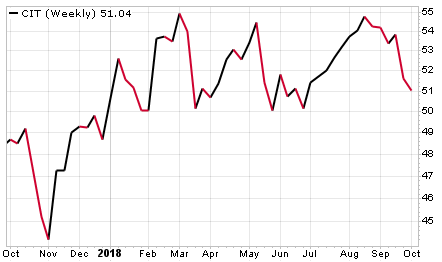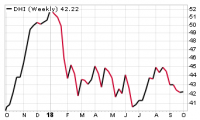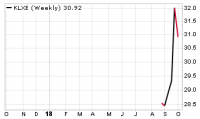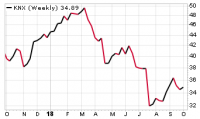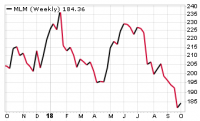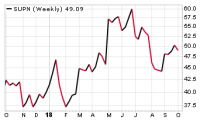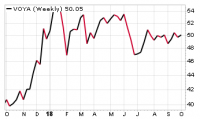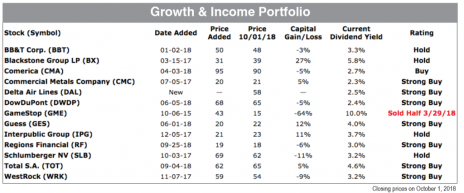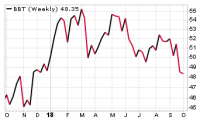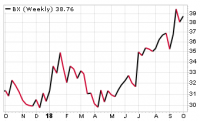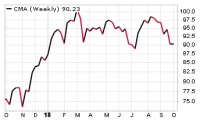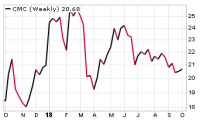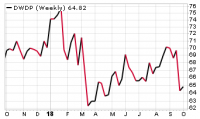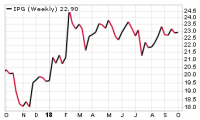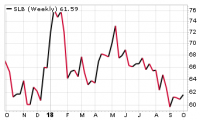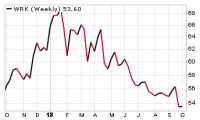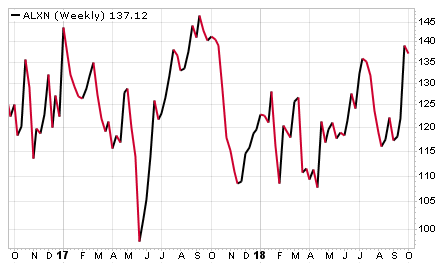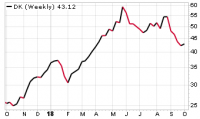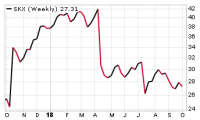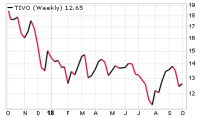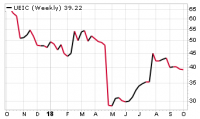Today I wrote about a company that announced a new CEO! I then went back and added to the story. My conclusion remains unchanged: I expect the stock to perform poorly through year-end and possibly quite a ways into 2019.
Cabot Undervalued Stocks Advisor 1018
[premium_html_toc post_id="160704"]
General Electric: Still a Hot Mess
This week, General Electric (GE) announced that, after a brief tenure, CEO and Chairman John Flannery is being replaced by Larry Culp, former CEO of Danaher Corp. Don’t get all excited about Larry Culp, nor about yesterday’s jump in GE’s share price. Just because investors assumed that something positive is about to happen at General Electric does not mean the company is anywhere close to coming up with a plan to solve its problems.
The company announced larger-than-expected cash flow problems and a huge goodwill writedown. Investors can also expect an overdue and fairly inevitable downgrade of GE’s credit rating. That’s all bad news, which will be widely broadcast in hot-off-the-presses analyst research reports that get delivered to every institutional investor in the world.
The news gets worse. Larry Culp is an outsider, and his relevant business experience is actually the opposite of what the company needs right now. General Electric needs to consider selling assets and/or spinning off divisions. Culp has broad experience in corporate acquisitions.
Will Culp do something constructive for the company that John Flannery and the current Board of Directors couldn’t think up and couldn’t accomplish? Well, certainly not in a short time frame, which means the worst is not over for the share price.
It’s a coincidence that I wrote everything below this paragraph before news of the CEO change emerged. And what I wrote still stands! I wouldn’t own this stock. It’s going to be months before Culp will have anything good to report to investors. He’s got to start working, assemble a team, get the lay of the land, consider solutions, and negotiate those solutions with the Board of Directors before finally announcing those solutions to the public and implementing them. That pushes any significant press releases out into January, near the fourth quarter earnings release.
Last week, General Electric (GE) had a problem with a turbine in Texas that thrust the company back into the limelight. The turbine problem is fixable, and relatively inconsequential. Financial pundits focused on the GE share price, pondering, “How low can it go?”
I wrote articles about GE a handful of times during the last year, forecasting the 50% dividend cut and the plummeting share price. In my August article, “Four More Reasons to Avoid GE Stock”, I reiterated to investors that the share price would continue falling.
There are lots of “what ifs?” amid investors’ discussions about GE, and it can be hard to establish a firm foundation for a decision to buy, hold or sell. Fortunately, there’s one undeniable fact that investors can circle back to: stocks that have fallen throughout the year will virtually always continue falling through December 31, due to tax loss selling. That fact can guide the following three decisions:
Buy – Buy GE if you want to. The company is not a disaster; they’re not losing money. But if you wait until January 2, when tax loss selling is over, odds are very high that you’ll get in at a lower price than today, and that the stock will probably not fall further.
Hold – Sure, if you don’t mind watching the share price fall further through December 31. But keep in mind that the dividend is still at risk because the company has not yet solved its cash flow problems.
Sell – This could be a prudent decision. You can sell GE and put your capital into other investments that have better business prospects, stronger balance sheets, stronger earnings growth, more stable dividends, and/or more bullish price charts.
For GE shares, I vote “sell.” And if it looks like it might be wise to buy GE on January 2, I’ll definitely suggest that you do so. The stock still won’t meet my investment criteria in January, but that doesn’t mean you can’t make money on it. I’ll keep you posted!
Send questions and comments to crista@cabotwealth.com.
Portfolio Notes
Be sure to review the Special Bulletin from September 26 in which I mentioned news, rating changes and the price action on Alexion Pharmaceuticals (ALXN).
Quarterly Earnings Release Calendar
Mid-October: Blackstone Group (BX) and Skechers (SKX) – 3Q
October 16 am: Comerica (CMA) – 3Q
October 18 am: BB&T Corp. (BBT) – 3Q
October 19 am: Schlumberger (SLB) and Synchrony Financial (SYF) – 3Q
October 23 am: Regions Financial (RF) – 3Q
October 25 am: Baker Hughes, a GE Co. (BHGE) – 3Q and Commercial Metals (CMC) – 4Q
Late-October: Alexion Pharmaceuticals (ALXN), CIT Group (CIT) – 3Q, D.R. Horton (DHI) – 4Q, Interpublic Group (IPG) – 3Q, Knight-Swift Transportation (KNX) – 3Q, Martin Marietta Materials (MLM), Southwest Airlines (LUV) – 3Q
Early November: Delek US Holdings (DK), DowDuPont (DWDP), Quanta Services (PWR), Supernus Pharmaceuticals (SUPN), TiVo (TIVO), Universal Electronics (UEIC), Voya Financial (VOYA), WestRock (WRK)
Second half of November: GameStop (GME), Guess? (GES) and KLX Energy Services (KLXE)
Virtually all companies offer extensive information on their websites pertaining to their quarterly earnings releases, including press releases, conference calls, slide shows and/or webcasts.
Buy-Rated Stocks Most Likely* To Rise More Than 5% Near-Term:
Alexion Pharmaceuticals (ALXN)
Guess? (GES)
Total S.A. (TOT)
*I can review price charts and make an educated determination about what’s likely to occur, but I will sometimes be wrong. I cannot control the stock market; I can only guide you through it.
Today’s Portfolio Changes:
Delek U.S. Holdings (DK) moves from Strong Buy to Hold.
Delta Air Lines (DAL) joins the Growth & Income Portfolio as a Strong Buy.
Martin Marietta Materials (MLM) moves from Strong Buy to Hold.
Last Week’s Portfolio Changes:
Alexion Pharmaceuticals (ALXN) moved from Strong Buy to Buy.
Regions Financial (RF) joined the Growth & Income Portfolio as a Strong Buy.
Growth Portfolio
Growth Portfolio stocks have bullish charts, strong projected earnings growth, little or no dividends, low-to-moderate P/Es (price/earnings ratios) and low-to-moderate debt levels.
Featured Stock: CIT Group (CIT – yield 2.0%)
CIT Group (CIT) operates both a bank holding company and a financial holding company that provide financing, leasing and advisory services to small and middle market businesses, consumer markets and the real estate and railroad industries. Last week, the Equipment Leasing and Finance Association (ELFA) reported that new borrowing by U.S. companies for capital expenditures rose to $8.9 billion in August, up 14% year-over-year. In addition, the Equipment Leasing & Finance Foundation reported its confidence index for September is 65.5, a big positive jump from 60.7 in August.
If you believe that the Tax Cuts and Jobs Act caused U.S. companies to retain more cash than they otherwise would have, that the tax savings will be ongoing and that improving consumer confidence and employment data are not going to suddenly turn disastrous, then you should consider owning shares of a company that specifically profits from increases in corporate capital spending and consumer spending. CIT Group is a great candidate, with a very strong and stable earnings outlook, low valuation, attractive dividend yield and a share price that’s at the lower end of a stable trading range.
Analysts expect CIT Group’s full year EPS to grow aggressively at 21.8% and 28.1% in 2018 and 2019. The corresponding P/Es are low at 13.6 and 10.7. CIT’s earnings estimates haven’t changed by more than a penny since early August.
The stock has traded between 49 and 55 all year. That’s not exciting, but it creates opportunity for value investors who are willing to wait for the next share price breakout. Earnings season is coming up fast, with financial stocks leading the pack in mid-October. The market will eventually react to ongoing, excellent earnings performance throughout the industry. Strong Buy.
Updates on Growth Portfolio Stocks
D.R. Horton (DHI – yield 1.2%) is America’s largest homebuilder, also providing mortgage, insurance and title services. DHI is an undervalued growth stock. The stock fell in February with the 2018 market correction and has since traded between 39 and 47. Despite the inaction on the stock, the earnings estimates are 15% higher than they were in January, steadily climbing throughout the year. At this point, analysts expect EPS growth of 41.5% and 18.6% in 2018 and 2019 (September year end). The 2019 P/E is 9.1. DHI is still bouncing around. Strong Buy.
KLX Energy Services Holdings (KLXE) was spun off from KLX Inc. (KLXI) in a 4-for-10 ratio and began trading on September 17. (A person with 100 shares of KLXI received 40 shares of KLXE.) At a current price of 32.01, KLXE now represents a value of 12.80 per KLXI share. I’m awaiting the publication of the cost basis allocation between shares of KLXI and KLXE. I’ll share that with you as soon as it’s available.
I plan to hold KLXE for a short while, in order to assess any newly available information on the company and to be prepared to capitalize on any near-term price appreciation. Consensus earnings and revenue estimates will not likely be available until quarterly results are reported. I do not expect selling pressure on the stock, because anybody who owned KLXI and did not favor the prospects for KLXE would have already sold out. We’ll likely see additional near-term capital appreciation. Hold.
Knight-Swift Transportation Holdings (KNX – yield 0.7%) is a truckload carrier formed from the September 2017 merger between Knight Transportation and Swift Transportation Company. Knight-Swift is an undervalued industry leader with an exemplary management team. KNX is a mid-cap aggressive growth stock. Analysts expect full year EPS growth of 65.2% and 18.0% in 2018 and 2019. The corresponding P/Es are 15.1 and 12.8. The numbers look great and the stock is coming up off its lows since late July. Strong Buy.
Marathon Petroleum (MPC – yield 2.3%) is the nation’s second-largest energy refiner, with interests in processing facilities, 10,000 miles of oil pipelines, and product sales in 8,000 retail stores. Marathon just purchased Andeavor (ANDV), which brings 10 refineries and another 3,300 retail stores under Marathon’s umbrella. Yahoo Finance is bullish on Marathon, expecting a “blockbuster quarter”. Consensus earnings estimates change weekly for Marathon. The market is now expecting aggressive EPS growth of 38.8% and 30.0% in 2018 and 2019. Corresponding price/earnings ratios (P/Es) are quite low at 14.8 and 11.4. The price chart is generally bullish, although there was some heavy selling volume late last week that probably reflected activity relating to the finalization of the Andeavor purchase. Strong Buy.
Martin Marietta Materials (MLM – yield 1.1%) is a supplier of crushed stone, sand, gravel, cement, concrete and asphalt. Despite the poor action in the share price this year, 2018 earnings estimates are 10% higher than they were five months ago, steadily climbing since May. Analysts expect EPS growth of 29.9% and 19.4% in 2018 and 2019. The corresponding P/Es are 19.5 and 16.3. Management is bullish that the construction recovery in the U.S. will accelerate in the second half of 2018 and continue next year. MLM is an undervalued aggressive growth stock. I’m moving MLM from Strong Buy to Hold until the share price stabilizes and turns upward. Hold.
Quanta Services (PWR) provides specialized infrastructure and network services to the electric power, oil and natural gas industries. PWR is an undervalued mid-cap growth stock. Wall Street expects full year EPS to grow 40.1% and 16.4% in 2018 and 2019. The corresponding P/Es are 12.2 and 10.5. PWR has traded between 32.75 and 35.25 since mid-June. Strong Buy.
Southwest Airlines (LUV – yield 1.0%) is the largest U.S. domestic air carrier, transporting over 120 million customers annually to over 100 locations in the U.S., Central America and the Caribbean. Wall Street expects full year EPS to grow aggressively at 19.1% and 22.1% in 2018 and 2019. The corresponding P/Es are 15.0 and 12.3. LUV is trading in the low 60’s, with price resistance at its January high near 66. A typical surge in airline stocks during the fourth quarter could push LUV to new highs before year-end. Buy.
Supernus Pharmaceuticals (SUPN) focuses on the development and commercialization of products for the treatment of central nervous system diseases and psychiatric disorders, including epilepsy, migraine and ADHD. Supernus will present at the 2018 Cantor Fitzgerald Global Healthcare Conference on October 3. SUPN is an undervalued, small-cap aggressive growth stock. Analysts expect EPS to increase 50.8% and 30.0% in 2018 and 2019. The corresponding P/Es are 26.5 and 20.4. SUPN is rising with price resistance at 55 and 60. Buy SUPN now. Strong Buy.
Voya Financial (VOYA – yield 0.1%) is a retirement, investment and insurance company serving approximately 14.7 million individual and institutional customers in the United States. The company will host an Analyst Day on November 13, which could easily generate new and bullish research reports for Voya. The biggest question among institutional investors is whether Voya might sell its life insurance division; it’s not a problematic piece of the company, although the life division might be sold if an attractive price is offered. VOYA is an undervalued aggressive growth stock. Wall Street expects Voya’s full year EPS to grow 123% and 24.5% in 2018 and 2019. The corresponding P/Es are 11.6 and 9.3. VOYA appears capable of surpassing upside resistance at 51 soon, at which time it will likely retrace 55, where it traded earlier this year. Buy VOYA now. Strong Buy.
Growth & Income Portfolio
Growth & Income Portfolio stocks have bullish charts, good projected earnings growth, dividends of 1.5% and higher, low-to-moderate P/Es (price/earnings ratios), and low-to-moderate debt levels.
Featured Stock: Delta Air Lines (DAL – yield 2.5%)
A few weeks ago, I mentioned that Delta Air Lines (DAL) appears to be a very attractive stock. Now that the share price has pulled back a couple of dollars, I want to add DAL to the Growth & Income Portfolio before a new run-up kicks in to high gear. Here’s another great reason to buy DAL: I recently learned, while reading some Wall Street research, that airline stocks typically perform very well during the fourth quarter, averaging about 20% growth. (I imagine that in reality, there’s a very wide range of performance numbers, depending on the year, and depending on the particular airline. However, it’s nice to know that the odds are with us if we buy an airline stock in October.)
Delta Air Lines is a U.S. and international passenger and cargo airline with an extensive and efficient hub complex. The company participates in multiple joint ventures with foreign airlines, and recently increased its stake in Mexico’s Grupo Aeromexico to 49%. Delta was named World’s Most On-Time Airline in 2017 by FlightGlobal.
Despite wide fluctuations in energy prices this year, Delta expects to achieve margin expansion in late 2018, contributing to annual profit growth. Wall Street expects Delta’s non-GAAP earnings per share (EPS) to grow from $4.93 in 2017 to $5.60 in 2018 and $6.60 in 2019, reflecting very strong EPS growth rates of 13.6% and 17.9% in 2018 and 2019. It’s important for investors to know that consensus EPS estimates change frequently for airline stocks, with the price of fuel being a big factor in the constant adjustments. So beyond the exact figures, the important thing to focus on with Delta is that it’s a very profitable company, and that profits continue to grow at a brisk pace.
DAL is both a growth stock and a value stock. The stock’s 2018 and 2019 price/earnings ratios (PEs) are quite low at 10.1 and 8.6 respectively, leaving lots of room for share price increases before anybody would consider the stock to be overvalued.
Delta pays a quarterly dividend of $0.35, which increases annually during the third quarter. The current yield is 2.5%. Delta has also been spending cash on share buybacks, repurchasing 4% to 6% of outstanding shares in each of the last three years. Delta’s debt carries investment grade credit ratings from the three major rating agencies, and the company is focused on continued debt reduction.
Delta Air Lines has a market capitalization of $40.0 billion. Warren Buffett, famed CEO of Berkshire Hathaway (BRK), owns 9.5% of the outstanding shares of Delta Air Lines.
In January 2018, DAL rose to 59, its highest price since exiting bankruptcy in 2007. Then came the U.S. stock market correction, which caused DAL to trade sideways for seven months. As the market came out of its funk, both the S&P 500 index and DAL retraced their January highs in recent weeks, with DAL briefly poking above 59 before seeing its shadow and pulling back to about 57.
I expect the stock to surpass 59 quite soon and begin a run-up that could easily bring DAL into the mid-to-upper 60’s over the next three-to-twelve months.
DAL could appeal to growth stock investors, value investors, investors who look for rising dividends, and traders who would be happy to make 10% profit in a matter of months. Be ready to own Delta soon, especially upon a breakout past 59. Strong Buy.
Updates on Growth & Income Portfolio Stocks
BB&T Corp. (BBT – yield 3.3%) is a 145-year-old financial holding company with $222 billion in assets and 2,100 financial centers that serves businesses and individuals. The company is expected to report strong loan growth in the third quarter. The market expects BB&T to make a significant acquisition in the coming year. Analysts expect full year EPS to grow 41.9% and 9.6% in 2018 and 2019. Corresponding P/Es are 12.3 and 11.2. The stock fell through price support last week, so it will be a while before it resumes trading between 50 and 55. Hold.
Blackstone Group LP (BX – yield 5.8%*) is the world’s largest and most diversified alternative asset manager with $439 billion in client assets. The company deploys capital into private equity, lower-rated credit instruments, hedge funds and real estate. Presuming that Blackstone does not become a C-corp, analysts expect Blackstone’s economic net income (ENI) to grow 10.0% and 4.9% in 2018 and 2019. The P/Es are 12.3 and 11.8, and the stock is fully valued. I’m moving BX from Buy to Hold. BX is rising, largely due to excitement over the potential C-corp conversion. Hold.
*The payout varies each quarter, with the total of the last four announced payouts yielding 5.8%.
Comerica (CMA – yield 2.7%) is a financial services company engaged in domestic and international business banking & lending, wealth management and consumer services. Comerica is one of the most asset-sensitive banks in the U.S., with a very high percentage of variable rate loans, thus benefiting from rising interest rates. Consensus earnings estimates for 2019 have reached their highest point year-to-date. Analysts now expect EPS to increase by 48.3% and 12.5% in 2018 and 2019. The corresponding P/Es are 12.8 and 11.4. CMA is an undervalued growth & income stock. Concerns about lower third quarter loan balances have pushed the stock toward the bottom of its 2018 range, between 88 and 102. Buy.
Commercial Metals Company (CMC – yield 2.3%) is a recycler and manufacturer of steel and metal products, including rebar and fence posts. Commercial Metals specifically benefits from the recently increased tariffs on Turkish steel products. The company is expected to report fourth quarter EPS of $0.47 on the morning of October 25 (August year-end). CMC is an undervalued aggressive growth stock. Wall Street analysts expect EPS to grow 104% and 56.6% in 2018 and 2019. The 2019 P/E is 9.0. The stock is languishing at price support at 20.5. Strong Buy.
DowDuPont (DWDP – yield 2.4%) intends to break up into three companies by June 2019. The agriculture division of DowDuPont will be called Corteva Agriscience and will be spun off by June 1, 2019. The specialty products division of DowDuPont will be called DuPont and will be spun off by June 1, 2019. DowDuPont CEO Ed Breen will become CEO of DuPont. After Corteva Agriscience and DuPont are spun off, the remaining materials science division of DowDuPont will be called Dow Chemical. DowDuPont executive Jim Fitterling will become CEO of Dow Chemical.
As the separated companies compete head-to-head with their various industry peers, DowDuPont management expects the share prices to rise, in accordance with normal industry stock valuations. DowDuPont is currently expected to see strong EPS growth rates of 23.2% and 16.7% in 2018 and 2019. The corresponding P/Es are 15.5 and 13.3.
News of higher ethane prices—a feedstock for various DowDuPont products—pushed DWDP down to the bottom of its 2018 trading range last week. This is a perfect time to buy low on DWDP and lock in a slightly higher yield than was offered in recent weeks. I expect additional capital appreciation in 2019 as the spin-offs take place. Strong Buy.
GameStop (GME – yield 10.0%) is a potential buyout candidate. In recent weeks, management reiterated that they are actively pursuing a strategic review, which could lead to the sale of the company. There’s upside price resistance at 16.75 and again at 18. Hold.
Guess?, Inc. (GES – yield 4.0%) is a global apparel manufacturer, selling its products through wholesale, retail, ecommerce and licensing agreements. Revenue growth largely stems from expansion in Asia and Europe, while rising operating margins are contributing to multi-year earnings per share (EPS) growth. Wall Street expects EPS to grow 55.7% and 22.0% in 2019 and 2020 (January year-end). Corresponding P/Es are low in comparison to earnings growth rates, at 20.8 and 17.0. The stock is low within a stable trading range. Buy GES now. Strong Buy.
The Interpublic Group of Companies (IPG – yield 3.7%) is a large conglomerate of advertising, marketing, communication and public relations companies serving every global market. The share price has been slowly improving since mid-July, and could retrace its 2018 high near 25 later this year. I will likely retire the stock from the Growth & Income Portfolio thereafter, due to slowing 2019 earnings growth. Hold.
Regions Financial Corp. (RF – yield 3.0%) is an Alabama-based superregional bank serving the South, Texas and the Midwest via 1,500 banking offices. The bank offers commercial and consumer loans, wealth management, and insurance products and services.
Regions Financial is expected to achieve a notable increase in third quarter net interest income and also a nice drop in both operating expenses and the outstanding share count. As a result, the third quarter consensus earnings estimate is $0.36 vs. $0.32 in the second quarter. Banks will begin reporting third quarter results in mid-October. Regions is expected to increase full-year earnings per share (EPS) by 31.5% and 11.3% in 2018 and 2019. The corresponding price/earnings ratios (PEs) are 13.0 and 11.7.
RF hasn’t traded higher than 20 since 2008, so once it breaks through 20, I think it can achieve a nice run-up. And of course, if we’re lucky, Regions could become a buyout target. Strong Buy.
Schlumberger (SLB – yield 3.2%) is the world’s largest oilfield service company. The number of U.S. rigs drilling for crude oil and natural gas rose by one last week to a total of 1,054, up 114 vs. a year ago. SLB is an aggressive growth stock, undervalued based on 2019 numbers. Earnings estimates for 2019 have been trending downward in recent months. Analysts now expect EPS to grow 21.3% and 41.2% in 2018 and 2019. The corresponding P/Es are 33.9 and 24.0. The share price fell during the summer and has stabilized at price support dating back to December 2017. I will recommend its purchase when the stock seems ready to rise. Hold.
Total S.A. (TOT – yield 4.6%) is a French multinational oil and gas company – one of the industry’s seven “supermajors” -- operating in over 130 countries. Total recently announced its purchase of G2mobility, a French operator of car-charging points, putting Total’s number of charging stations near 10,000. Total additionally plans to invest in electric car infrastructure, and has also invested in natural gas vehicle fuels and batteries.
Analysts expect EPS to grow 30.1% and 17.4% in 2018 and 2019. The corresponding P/Es are low in comparison at 12.2 and 10.4. Last week I wrote, “The stock appears capable of an immediate breakout past 65,” which is a new all-time high. The breakout occurred, but the advance has barely begun. Nobody has missed the run-up! Buy TOT now. Strong Buy.
WestRock Company (WRK – yield 3.2%) is a global packaging and container company. WRK is an undervalued growth & income stock. Analysts expect full year EPS to increase 55.3% and 13.0% in 2018 and 2019. The corresponding P/Es are 13.3 and 11.8. The share price has been weak, and is not yet ready to rise. Strong Buy.
Buy Low Opportunities Portfolio
Buy Low Opportunities Portfolio stocks have neutral charts, strong projected earnings growth, low-to-moderate price/earnings ratios (P/Es) and low-to-moderate debt levels. (Dividends are not a portfolio requirement, but some of the stocks will have dividends.) Investors should be willing to wait patiently for these stocks to climb.
Sometimes a stock in the Buy Low Opportunities Portfolio produces good capital gains and the share price is no longer low, yet the stock remains an attractive investment. Those stocks will then be moved into the Growth Portfolio or the Growth & Income Portfolio.
Featured Stock: Alexion Pharmaceuticals (ALXN)
Alexion Pharmaceuticals (ALXN) is a biopharmaceutical company that researches and manufactures treatments of severe and rare health disorders. Last week, Alexion announced the acquisition of Syntimmune for $400 million up front and up to $800 million upon reaching performance milestones. Syntimmune is far along in the development of SYNT001, a treatment for warm autoimmune hemolytic anemia (WAIHA ), adding to Alexion’s pipeline of treatments for rare diseases. The Cowen & Co. analyst believes that SYNT001 could contribute $1 billion in annual revenue to Alexion. The acquisition was previously budgeted and will not therefore affect the 2018 earnings outlook. The deal is expected to close in the fourth quarter of 2018.
Alexion also revealed successful trials of Soliris in combating symptoms of Neuromyelitis optica (NMO), an inflammatory disease of the central nervous system. Management intends to promptly file an application with regulators for approval of Soliris in treating NMO, which could add hundreds of millions of dollars to Alexion’s annual revenue.
Investors may listen to the webcast of Alexion’s September 14 presentation at Morgan Stanley’s 16th Annual Global Healthcare Conference.
Potential net income from the Syntimmune acquisition and from the new Soliris label indication is not yet figured into consensus earnings estimates. ALXN is an undervalued aggressive growth stock. Analysts expect EPS to grow 23.4% and 18.4%. The corresponding P/Es are 19.1 and 16.1.
ALXN rose rapidly in September to price resistance at about 137. The stock will most likely need to rest (or pull back) while it gathers strength for its next run-up. The best case scenario this year—barring a takeover offer—is that ALXN could rise to the upper 140’s by year end, where it will still be undervalued. Buy on pullbacks. Buy.
Updates on Buy Low Opportunities Portfolio Stocks
Baker Hughes, a GE co. (BHGE – yield 2.1%) offers products, services and digital solutions to the international oil and gas community. Baker Hughes’ management expects good international revenue growth in the second half of 2018. The number of U.S. rigs drilling for crude oil and natural gas rose by one last week to a total of 1,054, up 114 vs. a year ago. BHGE is an undervalued aggressive growth stock with a very low debt-to-market cap ratio. Analysts expect EPS to grow 67.4% and 106% in 2018 and 2019. The corresponding P/Es are 46.8 and 22.8. BHGE is trading between 31 and 37, and will probably trade higher next year, barring a downturn in the broader market. Strong Buy.
Delek U.S. Holdings (DK – yield 2.3%) is a diversified downstream energy company, with businesses that include petroleum refining, transportation, marketing, renewables (producing biodiesel fuel) and asphalt operations. DK is an undervalued, aggressive growth, small-cap stock. Analysts now expect EPS to grow 369% and 57.5% in 2018 and 2019. The corresponding P/Es are ridiculously low at 8.2 and 5.2. The share price has been weak. I’m moving Delek from Strong Buy to Hold until the share price stabilizes. Hold.
Skechers USA Inc. (SKX) is an apparel company that designs and manufactures affordable footwear for people of all ages. Skechers is the third largest footwear brand globally, behind Nike and Adidas. International revenue is growing dramatically, including huge growth in China. Skechers remains a successful company with huge ongoing growth opportunities in international markets. Analysts expect EPS to fall (2.2%) in 2018 and then rise 14.4% in 2019. The stock has recently traded between 26 and 30. Strong Buy.
Synchrony Financial (SYF – yield 2.7%) is a consumer finance company with 74.5 million active customer accounts. Synchrony partners with retailers to offer private label credit cards, and also offers consumer banking services and loans. The company has been investing in mobile capabilities and expanding its online savings account into a full-service bank. Earnings per share (EPS) are expected to increase by 31.7% and 30.4% in 2018 and 2019 (December year end). The corresponding price/earnings ratios (P/Es) are extremely low at 9.1 and 7.0. The stock rose 10% in September then gave it all back at the end of the month. I expect SYF will continue to trade between 31 and 34 in October. My price target on SYF is 40, where the stock reached an all-time high in January. Strong Buy.
TiVo (TIVO – yield 5.6%) creates products and licensable technology that enable the world’s leading media and entertainment providers to nurture more meaningful relationships with their audiences. Last week, TiVo introduced Tivo Bolt OTA, a new system capable of recording four programs at once from an over-the-air antenna. Bolt TV owners can also access streaming services such as Netflix, Hulu, and Amazon Prime. TIVO is an undervalued growth stock with a very attractive dividend yield. Management is in strategic discussions with entities that are considering buying TiVo’s product and/or IP licensing divisions. Investors should expect a final, lucrative M&A announcement any time between now and year end. Buy TIVO now. Strong Buy.
Universal Electronics (UEIC) is a manufacturer and cutting-edge world leader of wireless and voice remote control products, software and audio-video accessories for the smart home; with a strong pipeline of new products in the areas of safety and security, climate control and lighting. Universal Electronics will present at the B. Riley FBR Annual Consumer & Media Conference on October 4. UEIC is an undervalued micro-cap stock. UEIC has been trading between 39 and 45 amid an uptrend. The next run-up could take the stock to 50 or 55. Buy UEIC now. Be prepared for volatility. Strong Buy.
[premium_html_footer]
Send questions or comments to crista@cabotwealth.com.
Cabot Undervalued Stocks Advisor • 176 North Street, Salem, MA 01970 • https://cabotwealth.com
YOUR NEXT CABOT UNDERVALUED STOCKS ADVISOR ISSUE IS SCHEDULED FOR November 6, 2018
Cabot Undervalued Stocks Advisor is published by Cabot Wealth Network, an independent publisher of investment advice. Neither Cabot Wealth Network nor its employees are compensated in any way by the companies whose stocks we recommend. Sources of information are believed to be reliable, but they are in no way guaranteed to be complete or without error. Recommendations, opinions or suggestions are given with the understanding that subscribers acting on information assume all risks involved. Copyright © 2018 - COPYING AND/OR ELECTRONIC TRANSMISSION OF THIS NEWSLETTER IS A VIOLATION OF THE U.S. COPYRIGHT LAW. For the protection of our subscribers, if copyright laws are violated by any subscriber, the subscription will be terminated.
[/premium_html_footer]


